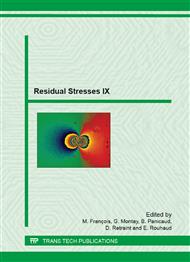[1]
A. Sollich, H. Wohlfahrt: Optimization of the fatigue strength of heat treated steels as a consequence of an optimum state of the surface and of subsurface layers after shot peening, The Sixth Int. Conf. on Shot Peening ICSP6 (1996).
DOI: 10.1002/3527606580.ch36
Google Scholar
[2]
U. Kleemann, H. Zenner: Structural component surface and fatigue strength - Investigations on the effect of the surface layer on the fatigue strength of structural steel components, Mat. -wiss. u. Werkstofftech. 37 (2006).
Google Scholar
[3]
W. Weibull: A Statistical Distribution Function of Wide Applicability, Journal of Applied Mechanics 18 (1951).
Google Scholar
[4]
A. Brückner-Foit, A. Heger and D. Munz: Evaluation of Failure Probabilities of Multiaxially Loaded Components Using the STAU Postprocessor, Proc. of the 17th Annual Conf. on Composites and Advanced Ceramic Materials (1993).
DOI: 10.1002/9780470314180.ch56
Google Scholar
[5]
A. Diemar, R. Thumser and J. W. Bergmann: Determination of local characteristics for the application of the Weakest-Link Model, Mat. -wiss. u. Werkstofftech. 36 (2005).
DOI: 10.1002/mawe.200400872
Google Scholar
[6]
H. Wohlfahrt: Einfluss von Eigenspannungen, Verhalten von Stahl bei schwingender Beanspruchung (1978).
Google Scholar
[7]
D. Löhe, K. -H. Lang and O. Vöhringer: Residual stresses and fatigue behavior, Handbook of residual stress and deformation of steel (2002).
Google Scholar
[8]
M. Suraratchai et al.: Modelling the influence of machined surface roughness on the fatigue life of aluminium alloy, Int. J. Fatigue 30 (2008).
DOI: 10.1016/j.ijfatigue.2008.06.003
Google Scholar
[9]
B. Winderlich: The local fatigue strength concept and its application to martensitic surface layers, especially laser hardened layers, Mat. -wiss. u. Werkstofftech. 21 (1990).
DOI: 10.1016/0142-1123(91)90616-7
Google Scholar
[10]
V. Schulze, J. Hoffmeister, M. Klemenz: Correlation of mechanical surface treatments, induced surface states and fatigue performance of steel components, Procedia Engineering 19 (2011).
DOI: 10.1016/j.proeng.2011.11.120
Google Scholar
[11]
J. Liu: Dauerfestigkeitsberechnung metallischer Bauteile, TU Clausthal (2001).
Google Scholar
[12]
Forschungskuratorium Maschinenbau (FKM): FKM-Guideline - Analytical strength assessment of components in mechanical engineering, 5th ed. (2003).
Google Scholar
[13]
R. Weber: PhD-thesis, to be published.
Google Scholar


